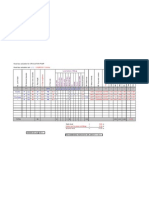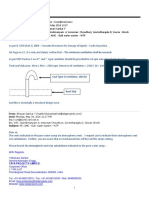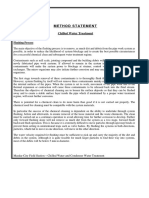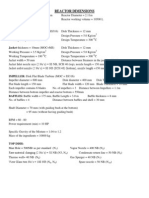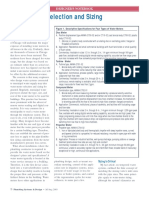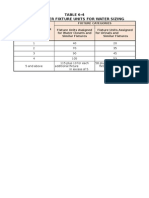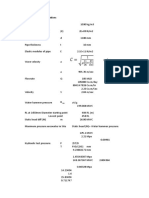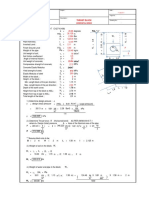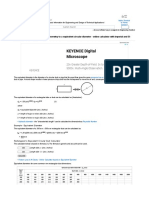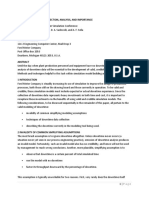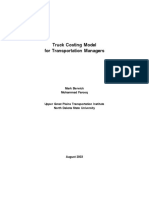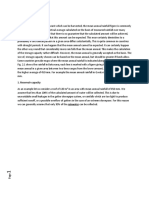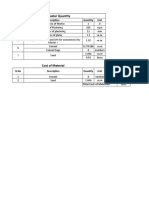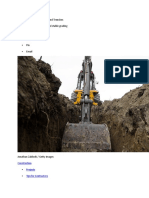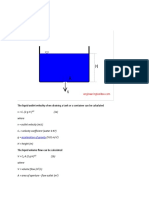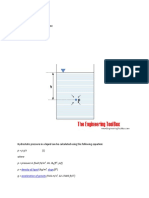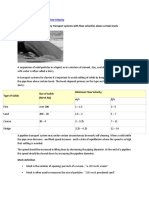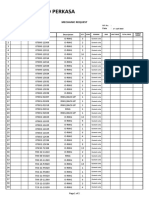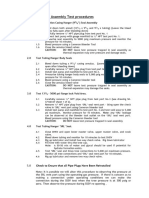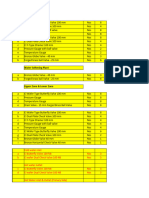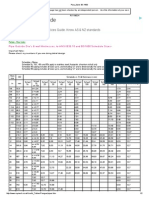Water Pipe Sizing Calculation Example – Part 1: Overview
Refer the above schematics (Fig.1) and observe the following inputs:
Total pipe length=7 meters
Pressure head=5 meters
Number of ball valves=2
Number of Tee bend=1
1|Page
�Also assume that the required flow rate at the pipe end is 0.5 liter/sec.
Find out the appropriate pipe size
Solution
Following stepwise procedure needs to be followed for finding out the appropriate pipe size of this
water pipe sizing calculation example:
Step-1: Assume the pipe diameter as 20 mm.
Step-2: Determine the Effective Pipe Length
Step-3: Determine the Permissible Pressure Loss
Step-4: Determine Hydraulic Diameter of the pipe
Step-5: Determine the Relative Roughness of the pipe
Step-6: Determine the Reynolds Number
Step-7: Determine the Moody friction factor using Moody diagram
Step-8: Determine the Actual Pressure Drop in the Pipe using Darcy-Weisbach equation and check if it is
below the permissible pressure loss as calculated in step-3
In the next part (part-2) of this pipe size calculation series will discuss about calculating effective pipe
length.
About
Latest Posts
Part 2: Determining the Effective Pipe Length
Refer the Part-1 of this piping system design calculations series to know the problem statement and the
assumptions.
What is Equivalent Pipe Length Method?
This the way of converting the Tee bends, valves and other pipe fittings in terms of equivalent pipe
length. This value is added to the already existing pipe length to calculate the effective pipe length. So
that the permissible pressure drop in the pipe can be expressed in terms of pressure drop per unit pipe
length.
2|Page
�Calculation
Getting back to our pipe size calculation, we have 2 ball valves and 1 Tee bend apart from 7 meters of
pipe line. And, also our initial assumption about the pipe diameter is 20 mm.
From the equivalent pipe length table it can be found out that
The equivalent length for the 20mm Tee bend = 1 meter
And, the equivalent length for the 20mm ball valve = 7 meter
So, the effective pipe length for our example= 1+7*2+7 meter = 22 meter
Pipe Sizing Calculation – Part 4: Determining Hydraulic Diameter of the Pipe System
What is Hydraulic Diameter of Pipe?
It is the equivalent diameter of a circular cross section pipe which produces same force kind of force
balance as that of the non-circular cross sectional duct. It is calculated from the following equation:
Hydraulic Dia (Dh) = (4* duct cross sectional area)/ (Wetted perimeter of the duct)…………………….Eq.1
The Dh (also called as hydraulic mean diameter) is used in the Reynolds number calculation and in the
Darcy–Weisbach equation.
For the water pipe sizing calculation example, we are dealing in this series,
the duct cross sectional area = π*D*D/4
the wetted perimeter of the duct = π*D
So, from the Eq.1,
Dh = D = 20 mm
Where,
D – Pipe diameter assumed in the Part-1
Pipe Sizing Calculation – Part 5: Determining the Relative Roughness Using Table
This article will show the table for absolute roughness (different to coefficient of friction) of pipe
surfaces of few commonly used materials. The absolute roughness is used in the relative roughness
calculation and in the water piping system sizing design calculations through Darcy–Weisbach equation.
3|Page
�Absolute Roughness Value table for Different Pipe Materials:
Pipe surface materials Absolute roughness value ( k in mm)
Aluminum 0.0012
Brass 0.001
Cast iron 0.26
Copper 0.0015
Concrete 0.3-3
Cement 0.3
Drawn tube 0.0015
Galvanized iron 0.15
Plastic, PVC 0 – 0.0015
Steel 0.045
The water pipe sizing calculation example, we are dealing with, has galvanized iron (GI) tubes. From the
above absolute surface roughness table we can see the value for GI pipe is 0.15.
Relative roughness is the ratio of the absolute roughness and hydraulic diameter.
For our home water tube sizing example,
The value of relative roughness =absolute roughness / hydraulic diameter (refer part-4)
= 0.15/ 20 = 0.0075
4|Page
�In the next part (part-6), we will calculate the Reynolds number for the piping system.
Pipe Sizing Calculation – Part 6: Determining Reynolds Number
eynolds number (Re) = ρ*s*L/μ ………………………eq.1
Where,
ρ – Density of the fluid
s – Velocity of the fluid
L – Characteristic length
μ – Dynamic viscosity
For our water pipe sizing calculation example, we have the following inputs (refer Part-1):
Fluid used = water
So, density of fluid (ρ) = 1000 kg/m3
Dynamic viscosity of fluid (μ) = 0.000894 Pa-S
Assumed flow rate = 0.5 Liter/sec = 0.0005 cubic-meter/sec
Assumed pipe diameter = 20 mm = 0.02 m
So, velocity of the fluid (s) = 0.0005/(π*0.25*0.02*0.02) = 1.591 m/sec
Characteristic length (L) = 0.02 m
By putting all the input values in the eq.1, we get
Re = 35592.84
As, the Reynolds number is greater than 4000, so, the flow in our case is of turbulent type.
The next part (Part-7) will deal with the selection of correct moody friction factor.
Pipe Sizing Calculation – Part 7: Reading Moody’s Friction Factor from Chart
Moody friction factor will be used as another input for the D’arcy-Weisbech equation which is used for
calculating the final pressure drop of the piping system design calculation example. The Moody’s factor
can either be calculated by using Colebrook equation or by using Moody diagram. We will use the
diagram for finding out the friction factor value for our water pipe sizing calculation example problem.
5|Page
� Fig.1: Moody
Friction Factor Diagram
Image Source: Wiki
How to Read the Moody Diagram
1. Find out the curve most closely matching with your relative roughness value.
For our example problem, we already found out the value of the relative roughness in Part-5 as 0.0075.
So I will use the 6th curve (0.01) from the top.
1. Find out the intersection point of the relative roughness curve and the calculated Reynolds
number.
For our example problem, we already calculated the value of the Reynolds number in Part-
6 as 35592.84. I have marked the approximated intersection point for our example by red dot in the
above Moody chart.
1. Draw a horizontal line from the intersection point towards the friction factor axis to find out the
approximate friction factor value. Adjust the friction factor value according to the difference
6|Page
� between the actual relative roughness value and the relative roughness curve you have selected
initially.
For our example, the approximate Moody friction factor value is coming around 0.04. And after
adjusting the final friction factor comes to 0.035.
In the next part (Part-8) of this piping sizing calculation tutorial we will use the D’arcy-Weisbech
equation to find out the final pressure drop.
Pipe Sizing Calculation – Part 8 – Determining the Actual Pressure Drop
We have reached the final part of the water piping system design calculation example tutorial. We will
use most of the data calculated so far (refer Part-1 to Part-7) as input for the D’Arcy-Weisbach pressure
loss equation. From this equation we will know the actual pressure or head loss in the pipe system. Then
we will check whether the actual pressure drop in pipe is less than the already calculated permitted
pressure loss in the piping system.
Darcy–Weisbach Equation for pressure head loss can be expressed as:
Δh = λ*(l/dh)*(v2/2*g)…………………………….Eq.1
Where,
Δh – Pressure head loss for the piping system
λ – Moody friction factor
l – Effective pipe length
dh – Hydraulic diameter
v – Velocity of the fluid
g – Gravitational acceleration (9.81 m/s2)
Getting Back to our problem:
7|Page
�For using the D’Arcy Weisbach formula (Eq.1) for our water piping system example, we have the
following inputs:
λ = Moody friction factor = 0.035 (refer part-7)
l = Effective pipe length = 22 meter (refer part-2)
dh = Hydraulic diameter = 0.02 meter (refer part-4)
v = Velocity of the fluid = 1.591 m/s (refer part-6)
g = Gravitational acceleration (9.81 m/s2)
By inputting the above values to the Eq.1, we will get the total head loss for our case as
Δh = 4.96 meter
Pressure head drop per unit length of pipe = Δh / l = 4.96/22 = 0.225 meter of head per meter of pipe
run.
Now refer the permissible head loss calculation of Part-3 and you will find that permissible value for our
case is 0.22 meter of head per meter of pipe run.
So, we can conclude that the pipe diameter of 20 mm, we assumed at the beginning of this tutorial, is
safe for the water piping system problem considered for this tutorial.
8|Page












